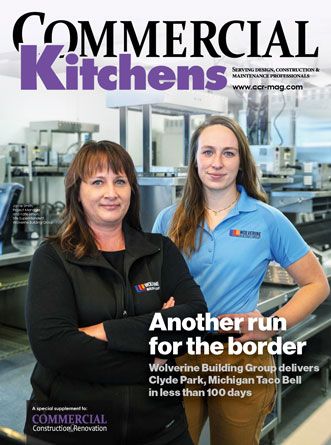Just a few months ago, you could shoulder your way into a crowded bar and order a drink, fill your plate with your favorite foods from a buffet, or try a sample off a shared tray offered at a restaurant. Those aren’t things anyone will be doing anytime soon thanks to COVID-19. It’s no secret that the pandemic has created a “new normal” for many industries, particularly the food industry. Even at a limited capacity, diners will only visit restaurants if they feel safe.
As restaurants across the country begin reopening, it’s crucial that they take enhanced precautions to mitigate risk and make diners feel safe. These are some of the essential trends in safety for foodservice companies in the COVID-19 era:
Hands-free technology: One major trend being implemented in existing commercial kitchens and new kitchen designs is making everything as hands-free as possible. This starts at the restaurant’s front door by making sure that all other doors can be easily opened by foot or forearm.
Hands-free technology also plays a big role in making kitchens and bathrooms safer. While hands-free, motion activated sink faucets are generally common in restrooms, this technology should also be incorporated into commercial kitchens. Commercial kitchens should also take advantage of other hands-free technology such as paper towel dispensers.
Social distancing barriers: Barriers have become standard for reopening restaurants and are becoming a part of everyday operations. Barriers are being used in several ways—placed at counters to separate guests and staff working registers, between tables, even the use of newly developed L-shaped barriers to separate guests in bars, as well as barriers that fit between booths.
While walking into a restaurant filled with barriers may be off-putting for some customers right now, it will likely become standard in the design of dining rooms as restaurants and bars work to keep customers and staff safer. When barriers do become a part of the design, they will be less evident to guests walking in. They also allow guests to be closer than six feet apart. While restaurants will not be operating at their normal capacity, social distancing barriers will allow for a greater capacity than would be possible without barriers.
No-Contact Carryout: Trends in streamlining carryout are also important. Many restaurants will have designated areas for carryout where guests can simply pick up their pre-paid order without even visiting a register. Because security may be a concern with this set up, locked food storage compartments are trending. These locker-like compartments can be unlocked via cell phone and have the option of a heated compartment.
Buffets: Many question how buffets can safely reopen. The answer—no more self-serve. We are currently working with a large government facility, as well as several hotel chains, to convert their buffets to a model similar to Subway or Chipotle where staff members can serve on one side and guests choose their food from the other side of a barrier. Schools with self-service lines will also need to take this approach to ensure the safety of students and staff.
One recent innovation in modified self-service is the “Sally” robot. Sally is an automated salad preparation system. Guests can choose from suggested salad recipes, or they can customize their own.
Standards in Dishwashing: Properly sanitized dishes are crucial to ensuring a safe dining experience. Hand-washing dishes will likely become a thing of the past. While chemical dishwashing machines are effective, high-temperature dishwashers are more efficient. High-temperature dishwashers quickly sanitize all dishes with 180-degree, virus-killing hot water making certain that the dishware is as clean and safe as possible.
Public Handwashing Stations: Already commonly used in Asia, freestanding handwashing stations in restaurant dining rooms provide diners with both a visual reminder to wash their hands before touching their food and an easy to use option compared with trekking to the restroom for handwashing. The more frequently and consistently diners wash their hands before eating, the lower the risk of transferring COVID-19 and other germs from their hands to their mouth, nose, and eyes, key entry points for viruses.
By: Herschel M. Pazornick, General Manager, Acme Paper & Supply Co. Restaurant Equipment and Supply Division
hpazornick@acmepaper.com
410-792-2333 Ext. 1292









 The 2024 virtual Men’s Round Table will be held Q4, 2024, date TBD.
The 2024 virtual Men’s Round Table will be held Q4, 2024, date TBD.











